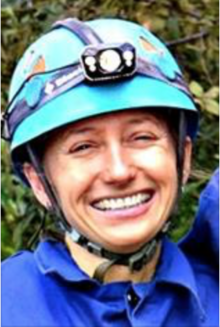Rising Star Expedition
In October 2013, Peixotto and five others were chosen to be part of a specialized excavation team for the Rising Star Expedition. [6] The purpose of the 21-day expedition, sponsored by The National Geographic Society and the University of the Witwatersrand, Johannesburg, was to excavate fossils which had been recently found in a deep cave complex in the Rising Star Cave System, near Johannesburg, South Africa. [7]
The critical skills and physical attributes sought for the excavation team by lead scientist and University of the Witwatersrand professor Lee Berger were a "master's degree or higher in palaeontology, archeology or an associated field; caving experience; and the ability to fit through an 18-centimeter (about 7-inch) space." [8] The six women scientists were crucial in the successful "excavation of arguably one of the most important fossil finds in human history – a new species referred to as Homo naledi." [9]
Peixotto, Hannah Morris, Marina Elliott, Alia Gurtov, K. Lindsay Eaves, and Elen Feuerriegel, along with a team of sixty international scientists, excavated "one of the richest collections of hominin fossils ever discovered—some 1,550 fossil fragments, belonging to at least 15 individual skeletons." [6]
Since this expedition, Peixotto has continued to work with a team to learn more about Homo naledi. [10] As of 2021, this team has discovered two dozen naledi individuals and evidence that suggests this cave system might have served as burial grounds for Homo naledi. [10]
Early life
As a child, Peixotto enjoyed searching her grandparents’ old Vermont farmhouse for artifacts. [16] [17] She initially studied engineering at college, but according to Peixotto, "When I took my first archaeology course, it was like a lightbulb turned on! I could combine all my experiences and interests in science, the outdoors, teaching, and history, to learn more about our collective human past." [16]
Peixotto was a Girl Scout. [17]
This page is based on this
Wikipedia article Text is available under the
CC BY-SA 4.0 license; additional terms may apply.
Images, videos and audio are available under their respective licenses.
